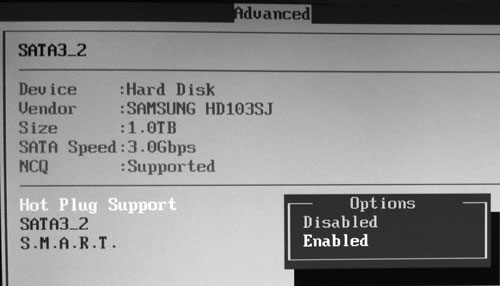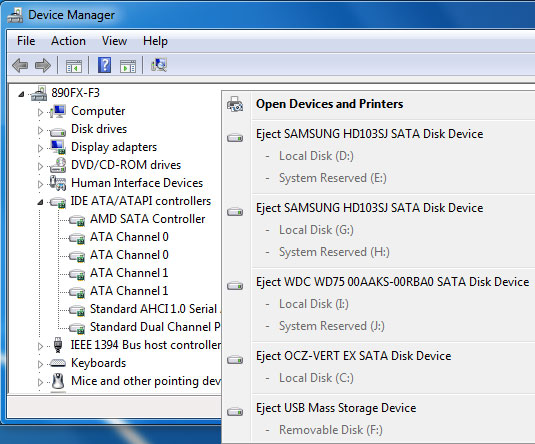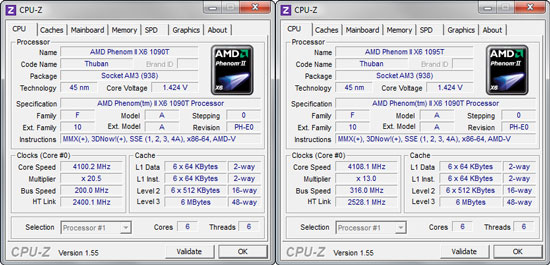ASRock 890FX Deluxe: Comprehensive Motherboard Review & Investigation of Thuban Performance Scaling
by Rajinder Gill on August 31, 2010 7:00 AM EST- Posted in
- ASRock
- AMD
- Motherboards
- 890FX
The Deluxe 4’s AMI-based BIOS is pretty straight-forward. Almost all overclocking related changes are made under “OC Tweaker” tab, and enthusiasts will feel right at home with familiar labels. We suggest you take a look at the Gallery for the individual pages of the Deluxe 4’s BIOS.
A notable item in the BIOS is the way ASRock manages SB850’s six SATA 6.0 Gbps ports as well as two of the Marvell’s. We’ve already commended how the Deluxe 4 matches the port numbers in the BIOS and on the PCB. Furthermore, ASRock somehow found a seamless way to make hot-plug/hot-swap to work from the BIOS, both for Windows native AHCI drivers and for AMD’s AHCI drivers. Windows and AHCI have had a rather tricky history, and although Windows 7 is miles ahead of previous iterations of Windows, we still run into trouble getting hot-plug function properly on occasions. Those who have attempted to take advantage of AHCI’s hot-plug/hot-swap might remember “Safely Remove Hardware” notification disappearing, or not showing up at all when it should. This often occurs upon installation of chipset drivers from AMD and Intel but Windows native AHCI drivers don’t seem to be immune to it, either.
The Deluxe 4 lets users handle this in the BIOS’s Storage Configuration section. Once AHCI is enabled, users can select individual drives to enable hot-swap/hot-plug. This worked for us with Microsoft’s AHCI drivers, AMD’s AHCI drivers, and with the “F8” method by loading the AHCI drivers at the time of OS installation. We are not sure how ASRock is doing this but it worked throughout our testing with both SSDs and mechanical drives, so we have no complaints.


Our retail 1090T CPU reached its maximum overclock of 4.10 GHz on the Deluxe 4 at 1.42V actual vCore using conventional air-cooling. Having a Black-Edition CPU makes overclocking easy on most boards if you simply want to take advantage of the unlocked multiplier. On the 890FX Deluxe 4 or any other board, our retail 1090T’s overclocking has been limited by heat for the most part. For maximum HTT overclocking, we lowered multiplier as low as x10 and reached 316 HTT, which coincidently got us to the same maximum CPU overclock of 4.10 GHz using x13 multiplier. For S3 Sleep/resume to work correctly the HTT had to stay at or below 290 HTT. Not bad, but not great. That should give enough room for the 1055T CPU (x14 multi) to reach its maximum potential, but it might not be enough for CPUs with lower multipliers. (There are rumors of more X6 CPUs from AMD later this year).

In general, the board tends to overvolt vCore under load by 0.04V with ensuing 0.02V or so vDroop. For example, when we set the vCore to 1.40V, the CPU received about 1.44V when the load is light (e.g. a single Super Pi instance), but when all 6 cores were loaded fully we measured about 1.42V. Once the CPU was idle and C1E kicked in, the board lowered the vCore below 1.20V accordingly.
Unfortunately, we found neither the BIOS reading nor Windows-based software including ASRock’s own OC Tuner utility correctly informs us of the actual amount of current the CPU receives. To make matters worse, the BIOS labels referring to vDroop control are highly misleading. The BIOS offers four options under “Load-line Calibration” section: Auto, Normal, Slight, Disable. We advise you to stick to “Normal” if you overclock, and to “Auto” for stock operation with TurboCore enabled, since the other two options will take your CPU to a voltage rollercoaster. “Normal” was also the most predictive of all as we exampled above, so without reliable software readings it is the only option we would take when overclocking an X6 CPU.
Memory overclocking on the Deluxe 4 was disappointing compared to our experience on ASUS M4A89GTD Pro/USB3. First and foremost, we warn you again the board overvolts memory by 0.05~0.06V so you should always subtract what you set in the BIOS by that amount. We set out to find out maximum stable frequency using 4 x 2GB and reasonable timings, and settled at DDR3-1666/7-8-7-1T at vDIMM set to 1.62V actual (1.57V in the BIOS). It was possible to run DDR3-1666/7-7-7-1T but it required us to set 1.62V in the BIOS, resulting in actual 1.67~1.68 vDIMM. The maximum frequency we reached with complete stability on 8GB configuration was DDR3-1800/8-9-8-2T. 4GB configuration with two DIMMs did fare slightly better, reaching stable DDR3-1800/7-8-7-1T. We were able to finish some tests @DDR3-2000/8-9-8-1T (1.67V actual), but it was nowhere near fully stable to finish our entire stressing test suit.
Overall, we feel the Deluxe 4’s memory overclocking is rather limited; the BIOS provides no control options for certain sub-timings that require adjustment as memory frequency is increased. This is obviously a matter of BIOS finesse, since we were easily able to achieve DDR3-2066/8-9-8-1T on the ASUS M4A89GTD USB3/PRO, using the same 4x2GB PSC kits. We hope ASRock will improve in this regard in the future BIOS releases, so that users will have more freedom exploring the limits of their hardware.
















42 Comments
View All Comments
Kane Y. Jeong - Wednesday, September 1, 2010 - link
We disabled Turbo Core for maximum overclocking. vCore was measured by a DMM.softdrinkviking - Wednesday, September 1, 2010 - link
nice review, good read.one thing I noticed, in your chart comparing the 890FX and 790FX, it says "TMSC 65nm," i am thinking that should be "TMSC 45nm."
or maybe i'm crazy, or maybe both are true?
softdrinkviking - Wednesday, September 1, 2010 - link
or is that the AMD890 chipset manufacturing process that's at 65nm?pkc - Wednesday, September 1, 2010 - link
I believe that it should be compared with ASUS M4A89TD Pro/USB3 and Gigabyte GA-890FXA-UD5 which are using the same chipset i.e. 890FXMacLeod1592 - Wednesday, September 1, 2010 - link
I currently run an ASRock 780G motherboard and was hoping theyd stepped it up a notch. My board also overvolts the CPU when I overclock. Its always a notch or two higher in CPU-Z than what I set it to in the BIOS.Mines also not a great overclocker. I cant get my Athlon X3 435 over 3.4 but all the reviews Im seeing have it at 3.6 and better!
Looks like Asus will be getting my money in the near future when I upgrade mobos.
siniranji - Thursday, September 2, 2010 - link
my question is , which thuban processor will perform well with this board, i have 1055T modelMrSpadge - Saturday, September 4, 2010 - link
Can I comment now?MrSpadge - Saturday, September 4, 2010 - link
Ups, that was unexpected. On to my actual comment regarding:"We have no conclusive theory to explain this phenomenon at this time. Originally our suspicion was limited to CPU-NB’s frequencies and memory frequencies/timings, but now we wonder whether the size of L3, which is meager 1MB per core for the X6’s, comes into play as well. We are looking to further examine this subject in the future."
Naturally modern games have very complex scenes so the CPU has to deal with a lot of data. Which data is not entirely predictable & prefetchable, so the CPU absolutely needs large caches. In fact, the caches can hardly be large enough - so main memory bandwidth and latency matters.
The encoding on all 6 cores on the other hand is a very regular task and the memory requests are quite predictable. The programmer or and / the cpu prefetchers are working to keep all the data in the caches before they are needed.
Or put empirically: If the app is programmed so well that it scales well from 4 to 6 cores [your encoding does], memory access can not be a problem here. And thus faster memory doesn't help much.
Regards, MrS
geok1ng - Monday, September 6, 2010 - link
There we have it again, a seminal article that will be quoted around the web for months to come.This easy to read article is the most complete and compreensive guide to AM3 plataform overcloking, and deserves to join the now famous "why we were wrong about the P45 chipset" article on C2D memory overcloking and the SSDs series.
To give you guys an example of the importance of NB overcloking on these AMDs hexacores, Tom Hardware´s has an article on the system builders marathon today that shows a 1055T system with SLI 480s. Th build fails to impress by about 20% agains a similar priced $2000 Intel system, and guess what? TH makes no mention of NB overclock!
RealTheXev - Friday, September 10, 2010 - link
I've run into several people who have had a 8xx series AMD chipset but have run into an issue of having an SB750 southbridge instead of the SB850.http://www.starcraft2forum.org/forums/showthread.p... for my write up.
My question is, will Asus be addressing this issue by adding the SB750 to their chipset drivers? Also, will this board possible be substituted for an SB750 southbridge as well? If so, I want to know the performance difference!
Asus isn't the only manufacture substituting the southbridge. I'm curious about the difference between the SB850 and SB750 variants of these boards and how likely it is a user will end up with one of these boards "substituted" boards.